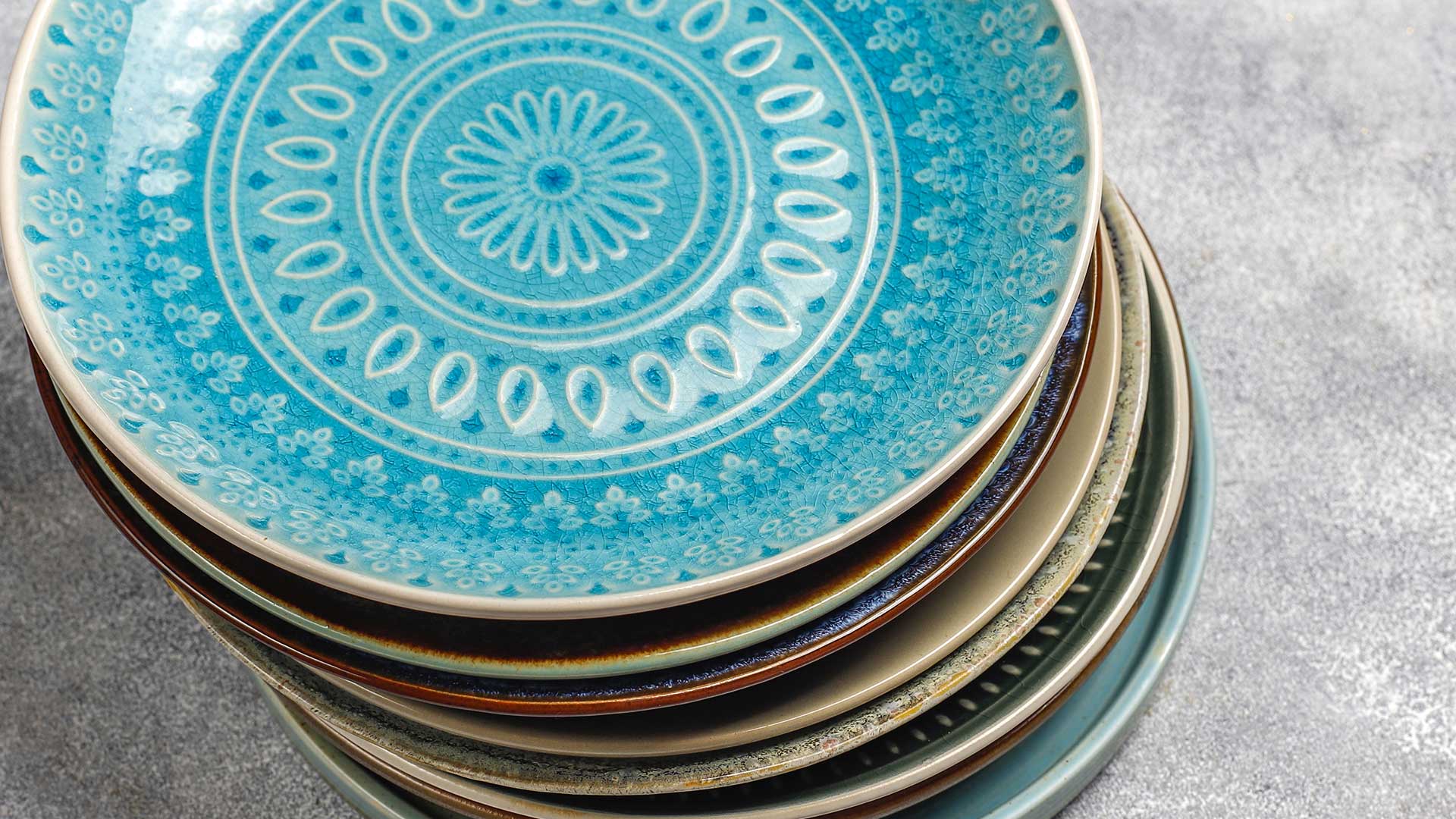Third firing decoration is a ceramic technique used since ancient times applied above all to tableware and objects.
The term third firing, in the ceramic field, refers to the third firing that is applied to an object or a tile that has already undergone two phases:
- First firing of the support or bisque firing
- Second firing of the glaze or glazing, to subsequently add the decorations in the multiple techniques.
Already at the “biscuit” stage, before the second firing, the ceramic could be painted with the underglaze technique which guarantees a brilliant and unalterable result over time thanks to the subsequent vitrification. When we talk about third firing, however, we usually refer to the overglaze technique.In artistic ceramics, the powder colors are blended with the addition of a fluid medium and are applied with a brush on the ceramic object. The latter is then subjected to a cooking of approximately 750-900 °.
The minerals contained in the color, during firing, melt with the vitreous coating of the porcelain becoming one with it. The decoration obtained can be more or less bright or even opaque, depending on the colors used, it is indelible, unalterable over time and very resistant to mechanical wear, as well as to most chemical agents.
All porcelains are usually decorated with third firing because, without the need for crystalline, due to their particular composition, once fired they become waterproof.
Although the “third firing” has a very ancient origin and strongly linked to artistic ceramics, the term has taken on a new meaning over time that recalls not only the technique, but indicates a real “specific sector” in the industrial chain of modern ceramics of wall and floor tiles.
The colors and lustres for the third firing
The third firing colors
The third firing colors used in artistic ceramics are used in third firing and the surface on which they are applied must be smooth and waterproof. Third firing colors are the only ones that usually do not dilute with water, but with oil or similar essences, as they must adhere to a surface that is no longer absorbent.
The use of these colors follows some specific rules: colors and ceramic materials are fired at different temperatures so the same object can be fired several times, creating particular effects and increasingly sophisticated surfaces.
The lustres and metals
Another category of third-firing “colors” are all lustres (colors with a metallic effect) and metals (gold, silver, etc.).
Everything that is metallic or metallized cannot reach high temperatures because it would lose the shiny properties that characterize it. To obtain these effects, the third firing at a lower temperature is then used and dedicated exclusively to lustres and/ ormetals.
However, there is an exception: Raku ceramic, a very particular ceramic firing technique, is characterized precisely by the fact that it obtains metallic reflections in a single firing with special glazes.
History of the third firing
The third firing yesterday
The art of ceramics dates back to about 10,000 years ago. It has been known since prehistoric times and it is thought that the first artifacts can be traced back to the Neolithic period.
The painted pottery was subsequently exported starting from Anatolia and the Syriac territories towards Europe around the third millennium BC.
The introduction of vitreous painting, in use starting from the second millennium BC. in Mesopotamia, further improved wear resistance and characteristics aesthetic.
In fact, it seems that the third firing technique was born and developed simultaneously in Persia and Mesopotamia, precisely in the cities of Kashan and Baghdad, in the 9th century. With the Islamic conquest, it spread throughout North Africa and Spain and then reached Italy in 1500 where ad hoc ovens were already used. Thanks to the push that the Renaissance gave to all the arts, the third firing also developed further in this historical period.
After the last splendor of the seventeenth century this process disappeared and only towards the end of the 1800s was a technique that had disappeared for almost two hundred years reintroduced.
At the same time, in 1800 the production of ceramics will begin to take on industrial characteristics and, in particular in Italy, this race never ended until today.
The third firing sector, in fact, has always been a precious ally of the Italian ceramic industries and manufacturers and suppliers of raw materials for producing tiles, allowing them to conquer new markets. Thanks to the graphic and decorative proposals that continuous research has allowed and still allows us to create, we have contributed to making ceramic Made in Italy known throughout the world: the combination of ceramic and decoration has always been the Italian winning card.
The division of the production cycle between support production and glazing and the consequent fragmentation of production, typical of the 1970s, gradually led to the birth of auxiliary companies. The third firing activity, in fact, was often carried out by small companies that allowed the ceramic industries to create lines of high quality artistic tiles, completing the product portfolio upwards.
The third firing today
It is not possible to ignore the gradual change in the tastes of customers over the last ten years who have expressed a preference for large formats often decorated in line, to the detriment of decor.
The commercial strategies of ceramic tile companies have in fact changed over time. It was preferred to undertake a race towards maximum profit, neglecting the decorative element, and this led to the proposal of fewer and fewer decorated products and “handmade” pieces, the trademark that had been distinguished Made in Italy for years.
The President of CerArte, Dr. Valler Govoni, already in 2015 insisted on the “technique of colorism”, a neologism he used to indicate all the techniques that lead to expressing ceramics through color and decoration as a distinctive element of Italian companies.
An important space can and still must also exist for the third firing industry, because the personalization of living spaces must also be done through “the art of decoration” which allows people to express their personality in the home. The color and the warmth of decorated ceramics cannot be completely replaced by the aseptic and minimal products that are prevalently offered today.
In fact, a reversal of direction has taken place in recent years: several third firing companies have gone to the markets with their own decorated products, with excellent feedback from retailers, architects and customers. Appreciation was also expressed for the entire tableware sector decorated with this technique as well as with the now more widespread technique of digital decoration.
However, the third firing industry still has potential that should not be overlooked.
Sicer products for third firing
Sicer, which has always been a world leader in the design, production and distribution of products for Third Firing, offers a wide range of products dedicated to ceramic decoration:
- Pigments for decoration
- Bases for screen printing and thickness
- Precious metals and lustres
- Metallic colors
- Raku glazes
Precious metals
Precious metal based products. They can be supplied in the liquid state, as gold in silkscreen paste or as platinum in silkscreen paste.
Precious metal based inks
This type of inks guarantees an optimal effect on both flat and structured surfaces.
Lustres
Special materials that allow to obtain iridescent effects on the ceramic surface.
In addition to this type of product, Sicer has a wide range of vitreous grits in its portfolio which contribute to making the ceramic decoration unique in its genre and difficult to reproduce on an industrial level.
The manufacturers and suppliers of raw materials for producing tiles, also following the latest market trends that “reward” decoration, has included in its portfolio various products specifically dedicated to the decoration of tableware.
We are talking about pigmented inks for direct printing on fired or raw ceramic surfaces in order to create extremely defined and detailed decorations.
In addition to these, Sicer offers a series of digital inks with UV technology that mainly uses the decal as a means of color transfer.
Frequently asked questions
The Third Firing technique is a ceramic decoration process involving a third firing, usually at lower temperatures than the initial glazing. It is used to apply final decorations with metallic or polished effects and guarantees high quality aesthetic results.
This technique makes it possible to apply special colours and lustres that would otherwise not withstand the higher temperatures of previous firings. It is ideal for achieving unique decorative effects such as metallic highlights and shiny or satin surfaces.
The most common glazes for Third Firing include metallic lustres and transparent glazes. These glazes have a lower melting point, around 700-900°C, and are applied to create bright and highly characterful decorations.
Sicer offers a range of special glazes, metallic lustres, and reactive glassware. These products make it possible to obtain decorated surfaces with special effects, combining tradition and technological innovation.
This technique is versatile and can be used to decorate tiles, tableware, decorative boards, vases, and other design objects, enhancing aesthetic details and unique surfaces.







